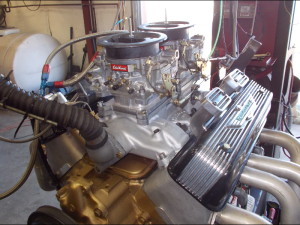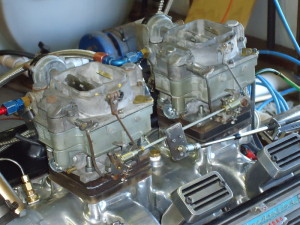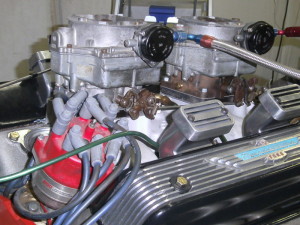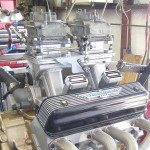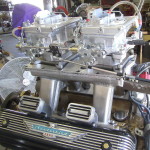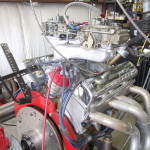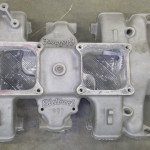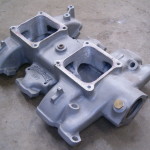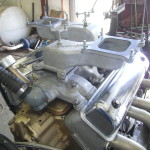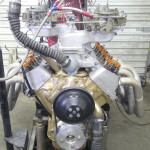With the iron 113 heads on the dyno mule, the Edelbrock #257 2X4 intake that had been ported by Joe Craine did exceed those numbers generated by the stock Mummert intake and single four barrel carb combination. Now it was time to install the aluminum heads on the 312+ dyno mule and see how those same dual quad manifolds would fare.
As a result of changing the ported iron ‘113’ heads to a pair of CNC ported Mummert aluminum heads, it was necessary to establish a new target baseline. The same stock Mummert intake and 750 cfm vacuum secondary Holley that had been used for the iron head baseline was again used for the aluminum head baseline. While the iron heads made a peak number of 311 HP in the single four barrel format, the aluminum head baseline jumps to 375 HP with nothing but a cylinder head change. This does give the dual quad intake testing a much higher target value to aim for.
The dual quad intake testing with the aluminum heads now gets more definitive simply due to the flow restrictions that were taking place in the iron heads being minimized. This will allow any flow restrictions in the manifolds and carb pairs to come to the forefront. With that in mind, the same intakes that were run on the iron heads are also run on the aluminum heads. But added to the fray are also the Fenton, Edmunds, Hogan, and the ported Edelbrock FM255 intakes among others.
Here is a quick summary of how the different intakes performed on the aluminum heads without getting into the various carbs or other variables that were tested on each intake. This particular list is ordered from worst to best using the best carb combination for each intake that was tested.
1. Edmunds D427 330 HP@5400, 343 TQ@3300
2. Ford EDB-C 1956 – modified 331 HP@5400, 352 TQ@4400
3. Ford ECG-D 1957 – stock 336HP@6000, 352TQ@3500
4. Ford EDB-C 1956 – stock 338 HP@5200, 369 TQ@4200
5. Edelbrock 257 – Hogged out 339 HP@6100, 337 TQ@4900
6. Fenton D427 342 HP@5400, 364 TQ@4200
7. Edelbrock 257 – stock 351 HP@6000, 355 TQ@4500
8. Mercury ECZ-C stock 357 HP@6100, 367 TQ@4300
9. Edelbrock FM255 stock 359 HP@6000, 370 TQ@4400
10. Hogans Tunnel Ram 361 HP@6100, 342 TQ@5200
11. Mercury ECZ-C ported 366 HP@6200, 375 TQ@4400
12. Edelbrock 257 – Ported by JDC 369 HP@6200, 378 TQ@4400
13. Edel FM255 – Ported by JDC 378 HP@6200, 370 TQ@4600
So with that being said, here are the breakdowns for each manifold that was tested. The manifolds are now listed in the order in which they were run and tested on the 322” mule engine.
Click on picture for larger images.
Ported Edelbrock #257 Intake:
Upon establishing the single four barrel baseline value, the Edelbrock #257 intake that had been ported by Joe Craine was the first of the dual quad intakes to be reinstalled on the aluminum headed +060 over 312. While that particular intake was the best of the lot on the iron heads and actually exceeded the baseline target for those heads, it came up just shy of the revised baseline or target for the aluminum heads. This intake was tested with several pairs of carbs and here are the results for the best tuneup for each pair of carbs. I’ll add that jetting changes on two carbs and especially the Teapots can be very time consuming.
L1434 Teapots (1957 2X4 carbs) 332 HP@5500, 365 TQ@3700
600cfm Edelbrocks 362 HP@6100, 367 TQ@4300
500cfm Edelbrocks 363 HP@6100, 366 TQ@4500
L1094-1 Linc Teapots (60P/82S jets)369 HP@6200, 378 TQ@4400
Click on pictures for larger images.
*******************************
Merc ECZ-9424-C Intake (ported):
Next on the list was the hard to find 1956 Mercury dual quad intake. In looking at this manifolds outward appearance, this one was originally based on the Edelbrock FM255 intake. There was already some prior port work performed on this intake and based on its overall performance, it was a good performer back in the day. Here are the results with a variety of carbs tested upon it.
1956 Mercury Carter carbs (vac sec) 347 HP@6000, 353 TQ@4500
L1161-2 Teapots with KM mods 354 HP@6000, 362 TQ@4400
L1094-1 Linc Teapots (60P/82S jets) 366 HP@6200, 375 TQ@4400
Click on pictures for larger images.
********************************
1956 Ford EDB-9425-C Intake (stock):
This was the ’56 Ford offering which had the center to center carb spacing much closer together than the ’56 Mercury intake that was just tested. The rear carburetor sits further forward on this manifold and appears to be more flow restricted as a result. Here are the results for this intake.
L1268 Teapots (1956 2X4 carbs) 327 HP@5500, 360 TQ@3700
L1434 Teapots (1957 2X4 carbs) 333 HP@5500, 363 TQ@3500
L1094-1 Linc Teapots (60P/82S jets) 338 HP@5200, 369 TQ@4200
********************************
Merc ECZ-9424-C Intake (stock):
Another 1956 Mercury 2X4 intake but this time it’s a stock and unmodified version. Here are the results.
L1434 Teapots (1957 2X4 carbs) 344 HP@5500, 364 TQ@3500
L1094-1 Linc Teapots (60P/82S jets) 357 HP@6100, 367 TQ@4300
Click on pictures for larger images.
********************************
Edelbrock FM255 2X4 Intake (stock):
This is the Edelbrock intake originally designed for the ‘55/56 heads and was the predecessor to the highly touted Edelbrock #257. This intake is also the basic design for the 1956 Mercury dual quad intakes which also posted similar performance numbers. Here are the results.
L1434 Teapots (1957 2X4 carbs) 342 HP@6100, 358 TQ@4500
GM Carter 1.050” mech sec 4V carbs 356 HP@5800, 368 TQ@4500
L1161-2 Teapots with KM mods 358 HP@6100, 362 TQ@4500
L1094-1 Linc Teapots (60P/82S jets) 359 HP@6000, 370 TQ@4400
Click on pictures for larger images.
********************************
Fenton ‘D427’ dual quad intake:
Here are the results for the Fenton intake which was an unmolested version (no porting). This intake has ‘D427’ cast on its bottom which leads me to believe that many of the Fenton manifolds were using some of the older Edmunds molds in which to cast them up.
1956 Mercury Carter carbs (vac sec) 324 HP@6000, 357 TQ@3300
L1161-2 Teapots with KM mods 338 HP@5400, 354 TQ@4500
GM Carter 1.050” mech sec 4V carbs 341 HP@5400, 362 TQ@4400
L1094-1 Linc Teapots (60P/97S jets) 342 HP@5400, 364 TQ@4200
Click on pictures for larger images.
********************************
Edmunds ‘D427’ Intake (stock):
Same drill, just another intake. This time it’s with an Edmunds intake with the ‘D427’ part number cast on its bottom.
L1434 Teapots (1957 2X4 carbs) 321 HP@5400, 357 TQ@3500
L1094-1 Linc Teapots (60P/82S jets) 322 HP@5400, 351 TQ@3900
L1161-2 Teapots with KM mods 330 HP@5400, 343 TQ@3300
********************************
1956 Ford EDB-9425-C w/mods:
And now back to the 1956 Ford dual quad intake but one that has been heavily ported in the plenum openings somewhere along the way. The carb openings themselves had been enlarged to accommodate carb adapters to fit later model carbs to it. The individual four carb bore holes had been converted to the kidney shaped holes as found on the 1957 ECG 2X4 intake manifolds. This particular manifold had also been heavily milled on the intake gasket surfaces which had the port openings smaller than they needed to be.
L1434 Teapots (1957 2X4 carbs) 321 HP@5400, 354 TQ@3500
L1161-2 Teapots with KM mods 329 HP@5400, 352 TQ@3300
L1094-4 Linc Teapots (57P/82S jets) 331 HP@5400, 352 TQ@4400
********************************
Hogans 2X4 Tunnel Ram:
This was a unique piece that falls in the sheet metal intake category and had been drag raced previously on the Church Brothers 1955 Thunderbird with much success. On their iron headed engine, it had made a best of 490 HP but when replaced by a nicely ported Blue Thunder intake with a single four barrel carb, 510 HP came to the forefront. While the Hogans intake is in the shop to see what can be done to its innards (plenum mods) to get it back on par with the single four intake, it is being run again with its ‘as supplied’ plenum with a myriad of carb pairs as part of this dual quad test. Here are the results.
L1094-1 Linc Teapots (60P/82S jets) 311 HP@6200, 307 TQ@5100
L1094-4 Linc Teapots (57P/82S jets) 324 HP@5900, 324 TQ@5200
Street Demon 625 cfm carbs 350 HP@6100, 345 TQ@4900
L1161-2 Teapots with KM mods 354 HP@6000, 329 TQ@5300
Predator 930 cfm variable venturi 356 HP@6100, 352 TQ@5000
L7996 450 Holleys w/mech secs 360 HP@5800, 344 TQ@5400
L4224 660 Cntr Sqtr Holleys 361 HP@6100, 342 TQ@5200
Click on pictures for larger images.
********************************
Stock Edelbrock #257 Intake:
The Edelbrock 257 has long been considered to be the gold standard of YBlock dual quad intakes. Here are the results for the stock Edelbrock #257.
L1434 Teapots (1957 2X4 carbs) 328 HP@5500, 353 TQ@4200
1956 Mercury Carter carbs (vac sec) 331 HP@6100, 352 TQ@3400
L1094-1 Linc Teapots (60P/82S jets) 333 HP@6100, 354 TQ@4200
L1161-2 Teapots with KM mods 344 HP@6100, 353 TQ@4400
GM Carter 1.050” mech sec 4V carbs 345 HP@6100, 358 TQ@4400
Street Demon 625 cfm carbs 351 HP@6000, 355 TQ@4500
********************************
Edelbrock #257 “Hogged Out”:
On this particular intake, the plenum dividers under each carb had been completely removed which played havoc with the carburetor signal. This intake had been run previously on the iron heads and was the worst performer of the manifolds tested on those heads. It did not fare much better on the aluminum heads while low end throttle response proved to be even worse with the better flowing aluminum heads. As a result, dyno pulls had to be started at 3500 rpms rather than the normal 2500 rpm start. While one pair of carbs were run on this manifold in an inline setup, a pair of Offenhauser crossram adapters were also utilized and tested in an effort to help save the manifold. Here are the results.
Inline: Street Demon 625 cfm carbs 272 HP@5100, 293 TQ@4600
Crossram: 660 Holley cntr squirters 339 HP@6100, 331 TQ@4500
Crossram: 625 Street Demon carbs 339 HP@6100, 337 TQ@4900
Those open plenums were not at all happy with the carbs sitting directly above them. Installing the crossram adapters which both lengthened the runners as well as shielded the bottom of the carb directly from the ports was worth an easy 67 horsepower. Even with a 67 HP gain, that manifold still comes in at the lower performance end of the list and still lower in output numbers than an unmodified #257 intake. The lesson here is to be cautious in porting these manifolds as it is quite easy to go the wrong direction when attempting to increase the power levels.
Click on pictures for larger images.
********************************
Ported Edelbrock FM255:
With the results being much better with Joe Craine porting the Edelbrock 257, it was decided to also see what Joe could do with the Edelbrock FM255 intake. The stock FM255 actually performed better than the stock 257 so it stood to reason that a ported FM255 might also perform better than a ported 257. Here are some of the results.
1956 Mercury Carter carbs (vac sec) 347 HP@6000, 359 TQ@3300
L9776 450 cfm mech sec Holley 349 HP@6100, 354 TQ@4500
L1434 Teapots (1957 2X4 carbs) 350 HP@6000, 362 TQ@3400
GM Carter 1.050” mech sec 4V carbs 353 HP@6100, 359 TQ@4400
L8007 390 cfm vac sec Holley 353 HP@6100, 360 TQ@3400
L1094-1 Linc Teapots (60P/82S jets) 361 HP@6100, 370 TQ@4400
L1094-4 Linc Teapots (57P/82S jets) 361 HP@6100, 371 TQ@4400
L1161-2 Teapots with KM mods 362 HP@6100, 362 TQ@4400
But this is where things get interesting. It’s observed that the mechanical secondary carbs have some severe reversion coming back up through them when loading the engine at 2200-2500 rpms. To alleviate this, a 2” HVH tapered carb spacer is installed under each carb. But going with what Joe Crane had seen in some air flow testing, the spacers were tested in both the conventional right side up configuration and upside down. The upside down configuration looked like a better fit to the four holes existing in the carb adapters that were being used to accommodate using modern carburetors on the teapot flanged intake. The spacers being upside down peaked at 372 HP with the 660 cfm carbs. Regardless of looking better, the spacers being right side up while using the same carbs netted 378HP. That’s a 6 HP change that didn’t cost anything but the time it took to reverse the spacers. It becomes obvious at this point that there is no end to the number of variants that can be tested.
With the same L9776 450 cfm Holley carbs reinstalled but with the upside down HVH spacers now under them, there is an eighteen horsepower increase. That’s pretty substantial for just a pair of carb spacers being installed. The pair of 660 cfm center squirter Holleys are then bolted on with the spacers being tested in both positions and the performance again steps up another notch. Here are the final numbers for both sets of these carbs.
L9776 450 cfm mech sec Holley 367 HP@6100, 350 TQ@3300
L4224 660 cntr sqrtr Holleys 378 HP@6200, 370 TQ@4600
The Offenhauser crossram adapters worked so well on the ‘hogged out’ Edelbrock 257 intake that it was decided to also try them out on a manifold that was already at the top of the field. In this instance and on the ported FM255 intake, performance went backwards. Here are the numbers.
Crossram: L4224 660 Holley 352 HP@6200, 357 TQ@4500
Click on pictures for larger images.
******************************
Stock ECG-4224-D 1957 Ford:
And this manifold completes the dual quad testing. It’s tested only with two different pair of model 4000 Holleys (Teapots). Here are the numbers.
L1434 Teapots (1957 2X4 carbs) 326 HP@5500, 355 TQ@4100
L1161-2 Teapots with KM mods 336 HP@6000, 352 TQ@3500
*********************************
In Summary:
Although I was on the trail of a couple of Edelbrock M254 intakes to also include in the testing, getting either of the intakes here for the test just didn’t happen. The M254 2X4 intake was designed for the smaller port Ford 239 and Mercury 256 heads so I suspect it would have really been flow restricted on the aluminum heads. Without actually testing that particular manifold, I can only guess that its performance would have been on par with the Fenton and Edmunds intakes.
One thing that became clear throughout these tests was what worked for carburetor pairs on one intake manifold did not necessarily work for another intake. While the Lincoln Teapots performed quite well on some of the basic low rise dual quad intakes, they failed miserably on the tunnel ram. On that particular intake manifold, two different sets of Lincoln carbs were used and both sets simply would not throttle up properly. It’s a good guess that there was just enough reversion from those short and straight runners to be upsetting the metering in those particular carbs. The carbs essentially sit right on top of the runners on that particular setup. But the pair of 1956 Teapots (List #1161-2) with the Karol Miller modifications shined in that particular application. Still trying to figure that one out but the internal secondary vacuum signal has been altered significantly on the KM modified Teapots which may be compensating for any reversion taking place. The 660 cfm center squirter Holleys also worked very well on that intake as compared to some of the other carbs tested but that was the application for which they were specifically engineered. But on the throttle up, all eight barrels were wide open on the 660’s versus only four barrels initially open on the vacuum secondary KM modified Teapots. Lots to think about.
So there you have it. Most of the dual quad intakes that were available for the Y have been tested and compared against each other. Only in the best of circumstances did a dual quad setup exceed those performance baseline values established by a stock unported Mummert single four barrel intake. Porting definitely works but if running aluminum heads, you do have your work cut out in getting the air flow numbers high enough in the dual quad intakes to match the cylinder head flow.
The next installment of the dual quad testing will cover the results derived from testing the various dual quad air cleaners. Stay tuned and until next issue, happy Y motoring. Ted Eaton.
This article was originally published in The Y-Block Magazine, Issue #116, May-June 2013.



